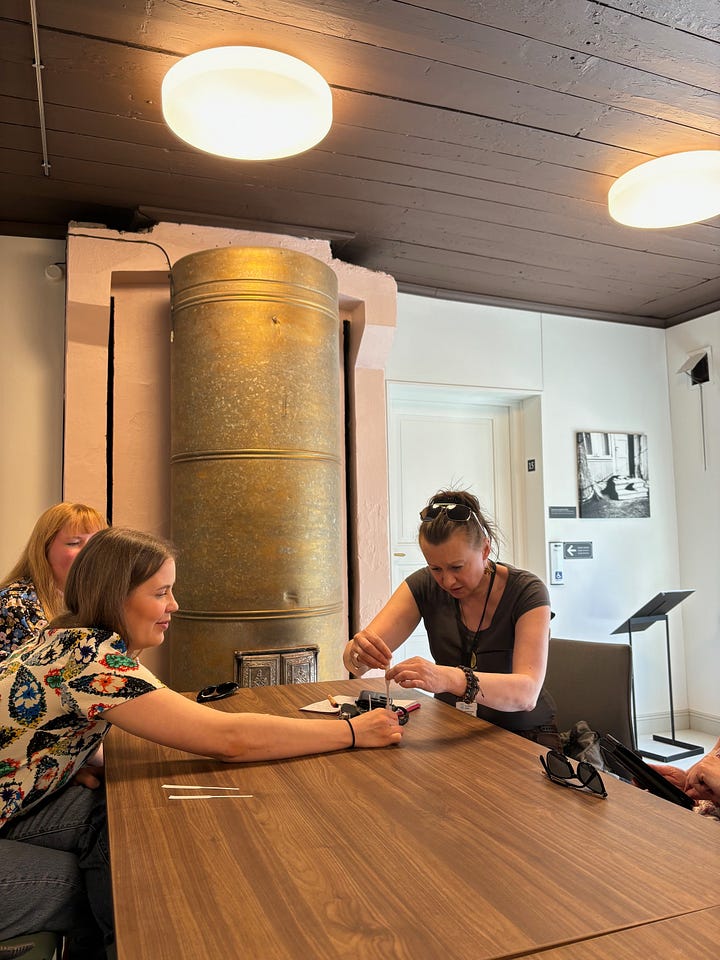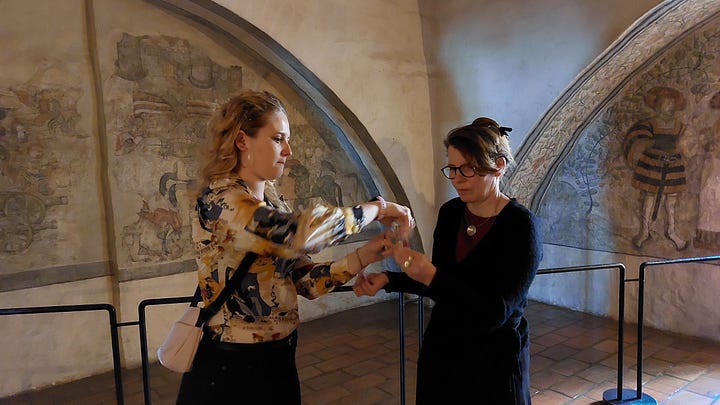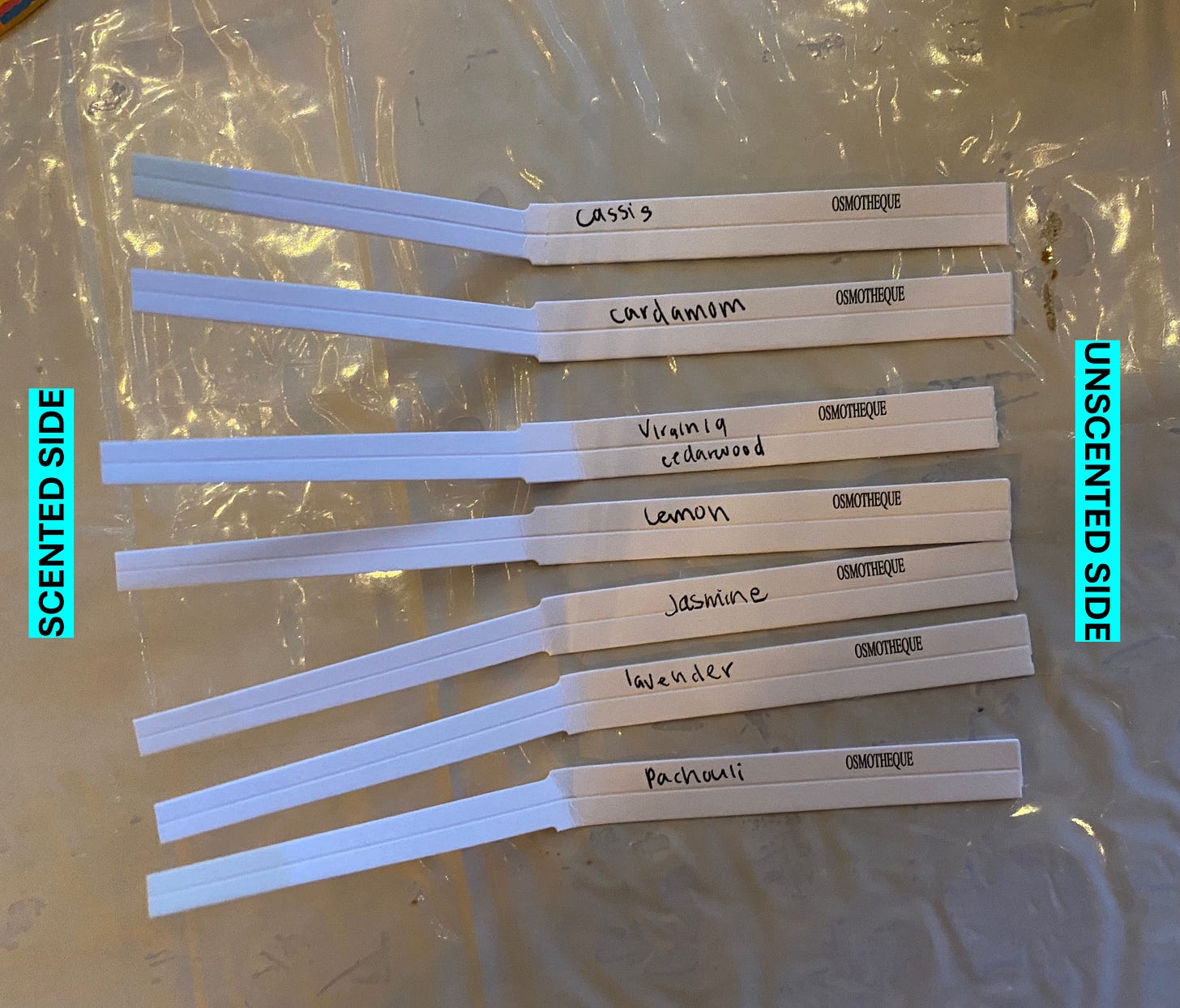How do I use the blotter technique in the museum?
In this post, I explain how to use a blotter as an olfactory storytelling technique in the museum setting.
Olfactory event design can be one of the biggest challenges of working with smell in the cultural heritage sector. My favorite technique for bringing smell into the museum is the blotter technique.
What is a blotter?
I am sure that you have used a blotter (AKA fragrance sticks or perfume test paper) before, perhaps at your local perfume shop or beauty counter. Blotters are typically used to test out different perfumes and to better understand which one you favor most, without the need to spray onto your skin.
These acid-free, paper sticks come in different forms, for example very wide or very narrow with a pointed tip. They also can come bound in booklets or individually in packs. For the use of olfactory storytelling, I suggest a narrow blotter that can easily fit in the neck of bottles of scent.
How do I use a blotter as a means of olfactory storytelling?
One of the things I love about the use of a blotter is that it is flexible, mobile and offers the best sniffing experience. You can use the blotter technique when giving a lecture or a workshop, during a museum guided tour or in small groups when conversing about a certain topic. Of course, the use of the blotter may require the facilitation by someone who dips and hands out the blotter with some information or context of the scent. But this is helpful as it can help guide the story that you want to tell.
It is also possible for a blotter to be used without the facilitation of others (this is how you do it at Sephora right?). But you run the risk of misuse of the fragrant material in the museum galleries (spilling, spraying, misinterpretation of context), so I do not personally recommend this.
Why use a blotter?
There are many pros to using the blotter technique in museums. As mentioned before, they are variable in use and mobile, so they can be carried around. They are also budget friendly, can be personalized and can be kept by the visitors as a keepsake if desired.
I also think that a blotter gives the most dynamic fragrant experience, conveying the scent’s top, middle, and base notes. In my experience, visitors like this as the scent changes over time.
Are there downsides?
Blotters can be cumbersome in preparation and use. Due to this, I always recommend blotters when you are working with a smaller group (+/- 30 people).


See the Blotter Technique in Action and Apply it Yourself!:
I always use blotters, from lectures to guided tours. When I was just in Turku, Finland, I trained the staff at the Turku Museum Center how to use blotters by presenting a scent in front of an artwork. In this case I dipped about 10 blotters into a bottle of fragrance on the spot. Please note that I always recommend preparing blotters away from the gallery to mitigate risk.
When Odeuropa designed the olfactory guided tours with Museum Ulm in Germany, we recommended the blotter technique. You can read more about that here.
Step by step instructions for using the blotter technique can be found as part of Odeuropa’s Olfactory Storytelling Toolkit Guidelines for Conducting an Olfactory Guided Tour here.
Tips when using a blotter:
Did you know that you can dip more than one blotter at a time? I usually dip up to 10 at a time (depending on the bottle).
Avoid cross contamination! Never use a blotter twice and do not dip the same blotter in 2 different bottles of scent.
I often use blotters in collaboration with a “glassine bag.” This is handy when giving a lecture as you can prepare blotters in advance and store them in the sleeve. Or you can offer visitors to take these blotter - glassine bag duos home with them as a keepsake.
When using a blotter, always instruct your participants on how to use it and where to sniff. Always hand visitors the blotter with the unscented end facing them and remind them not to touch their nose with the scented end.

Helpful links:
Blotters can be purchased on Amazon or on online shops like Aroma-Zone.
If you are in Europe, you can purchase blotters with your logo from Scentis-Shop. Their “glassine bags” are my favorite, see here.
Further reading:
Ehrich, S. C., et al. “Olfactory Storytelling Toolkit: A 'How-To' Guide for Working with Smells in Museums and Heritage Institutions”. Olfactory Storytelling Toolkit: A 'how-to' Guide for Working with Smells in Museums and Heritage Institutions, Odeuropa, 4 Dec. 2023, doi:10.5281/zenodo.10254737. (see page 147, 156)
Ehrich, S. C., et al. “Olfactory Storytelling Resource 11: Guidelines for Conducting Olfactory Guided Tours”. Olfactory Storytelling Toolkit: A 'how-to' Guide for Working with Smells in Museums and Heritage Institutions, Odeuropa, 10 Nov. 2023, doi:10.5281/zenodo.10102080.
Verbeek, Caro, Inger Leemans, and Bernardo Fleming. "How can scents enhance the impact of guided museum tours? towards an impact approach for olfactory museology." The Senses and Society 17.3 (2022): 315-342.




